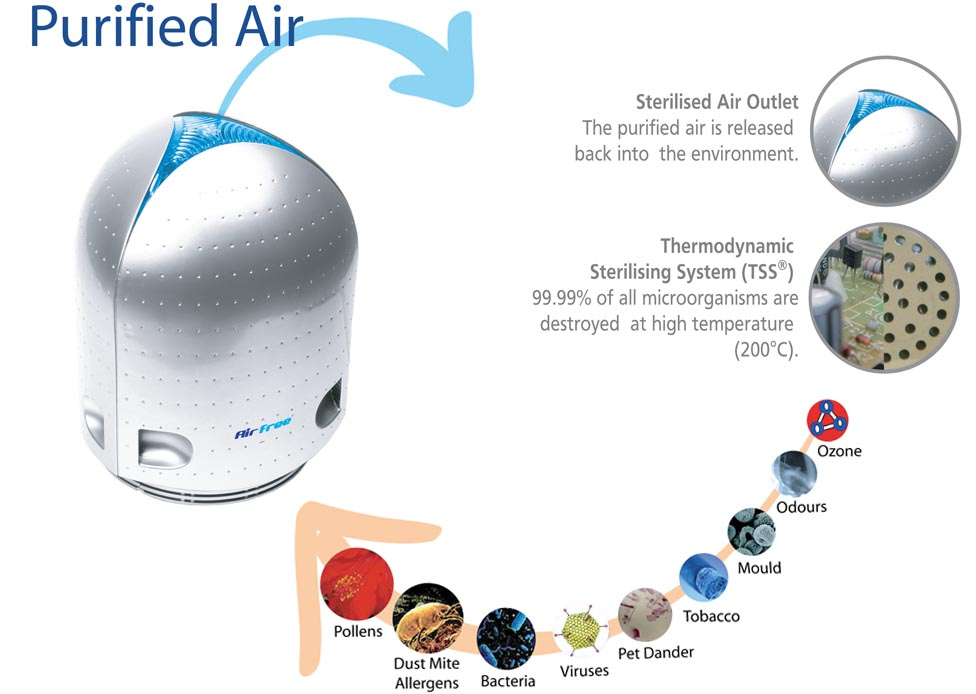Offices

The indoor spaces that contaminate us!
Currently we can observe the increasing tendency to construct buildings that are closed in, with little open spaces for ventilation, which use less energy to maintain air circulation and cooling.
However, as this type of construction solves the energy consumption problem, by reducing the inflow of outside air it accumulates chemical and biological pollutants generated in the internal environment, since the air renewal rate is not sufficient.
Chemical pollutants - such as carbon monoxide and carbon dioxide (CO and CO2), ammonia, sulfur dioxide and formaldehyde produced inside the buildings from construction materials, cleaning materials, cigarette smoke, photocopiers and the even human metabolism -, and biological pollutants - such as fungi, algae, protozoa, bacteria and dust mites, whose proliferation is favored by improper cleaning of carpets, rugs and curtains -, were the cause of what is conventionally called Sick Building Syndrome – SBS.
The Sick Building Syndrome refers to the cause and effect relationship of environmental conditions observed in indoor areas with reduced air exchange, and the various levels of aggression to the health of its occupants as a result of physical, chemical and/or microbiological pollution sources.
In 1982, WHO - World Health Organization - recognized the existence of Sick Building Syndrome when it was proven that air pollution inside a hotel in Philadelphia was responsible for 182 cases of pneumonia and for the death of 29 people.
Philadelphia was responsible for 182 cases of pneumonia and for the death of 29 people.
A building is considered "sick" when about 20% of its occupants exhibit transient symptoms associated with the time spent inside such building, which tend to disappear after short periods away from it. In some cases, leaving the place is enough to make the symptoms disappear. The main symptoms include irritated eyes, nose, skin and throat, headaches, fatigue, lack of concentration, and nausea, among others.
Other factors associated with Sick Building Syndrome are increased absenteeism rates and reduced productivity, as well as the quality of life of workers exposed to an environment that is unsuitable for occupation.
Thus, the indoor air quality assumed an important role, not only in public health issues,
but also in relation to Occupational Health.
POOR AIR QUALITY
Learn about the main responsible factors:
Bacteria
In 1976, U.S. officials were surprised by a new species of bacteria responsible for the onset of pneumonia in a group of World War II veterans. More than four thousand veterans were affected while participating in an American Legion Conference at a hotel in Philadelphia, where two hundred people were infected and thirty-four died.
Philadelphia, where two hundred people were infected and thirty-four died.
Mold (fungi)
Infiltration and moisture are predisposing factors to the onset of mold. Mold colonies spread releasing invisible particles in the air called spores, which when inhaled may trigger allergies (approximately 80% of those who are allergic are sensitive to mold) and even infectious diseases.
Mites
Mites are highly related to respiratory allergies and asthma. These microorganisms are found mainly in carpets, pillows and mattresses, and they prefer humid places that are rich in human skin desquamation. The waste produced by these animals contains substances that trigger allergies, and making the bed or vacuuming the floor may increase up to 1,000 times the concentration of these substances in the air. Even high-efficacy vacuum cleaners seem to be unable to remove them. (read about cleaning information at https://blog.airfree.pt)
Chemical agents
They are also responsible for poor air quality in offices. Cleaning products, tobacco and even perfumes can cause irritation to the respiratory tract. In order to mitigate the odors generated by the products, many offices use ozone generators. However, ozone is a gas that can cause irritation to eyes, nose, throat and lungs - and prolonged exposure can lead to permanent reduction in lung capacity. Children, especially those who suffer from asthma, are more susceptible to this gas.
AIRFREE® PURIFIERS are up to 99% efficient in destroying airborne mold spores, bacteria, viruses, ozone, mite and dust allergens, and other airborne allergens such as those derived from animals and pollen, and they are major allies in increasing quality of life through the air we breathe.
How do they work?
They dramatically reduce air pollution by burning the microorganisms. As a result, the contaminated air is drawn into the Airfree® ceramic core and destroyed at high temperatures. This air purification cycle is silent, requires no maintenance and is guaranteed by numerous tests.



